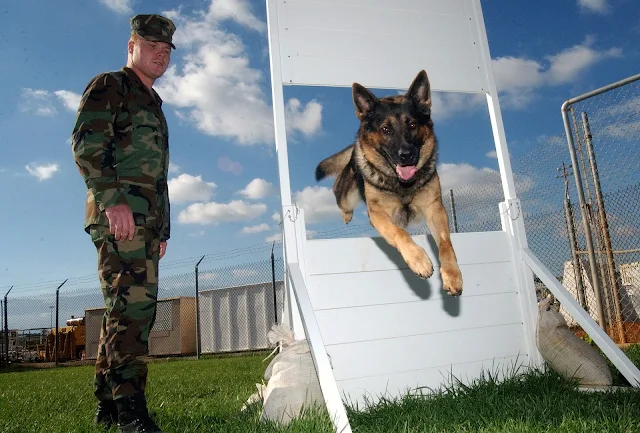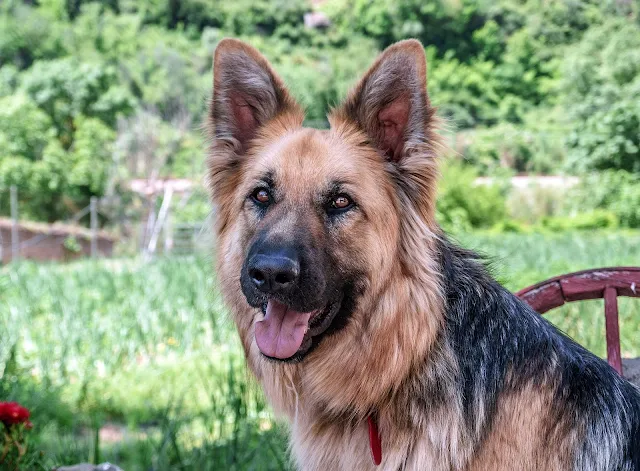Information about German Shepherd Dog Breeds
Information about German Shepherd Dog Breeds
A German Shepherd dog can be to happiest breed of large size for a cluster of working dogs. Smart because it is flexible, this breed was originally developed in a European country to protect and graze herds. The German Shepherd needs a lively way and makes it the perfect companion and guardian.
Physical characteristics
The German Shepherd dog has a double coat consisting of a thick coat and a dense, wavy or straight outer coat. His hair, usually black, red or black, is medium in length and is globally thrown throughout the year. The most different forms of rare colors vary between black and white, liver and blue.
The body of the German Shepherd is long - usually between 22 and 26 inches - in proportion to its length. This provides dog strength, agility, snap and long elegant steps.
 |
| German Shepherd Dog Breed |
Personal corruption
The shepherd dog protects and devotes incredibly to his family and residential, maintaining suspicious behavior and vanity around strangers. She may be dominant and firm towards dogs, with she 'wonderfully friendly with alternative pets inside the house.
shepherd dog is a highly versatile affiliated dog, displaying intense intelligence while dutifully active her.
shepherd dog is a highly versatile affiliated dog, displaying intense intelligence while dutifully active her.
Care
The shepherd dog will live outdoors in cool or temperate climates, however, enjoy living indoors as well. Repeated training or exercise sessions are a necessary box to keep him active and mind active.
As a shepherd dog sheds throughout the year, his coat should be cleaned once or twice a week to encourage a still rotation rate to reduce accumulation indoors.
As a shepherd dog sheds throughout the year, his coat should be cleaned once or twice a week to encourage a still rotation rate to reduce accumulation indoors.
 |
| German Shepherd Dog Breed |
the health
The Sheepdog has an average duration of 10 to 12 years. However, they are prone to some serious health conditions such as elbow abnormalities and canine hip abnormalities (CHD), still such as problems such as cardiovascular disease, angiogenesis, panoste inflammation, non-von Willebrand dysfunction (VWD), chronic myelopathy, equivalent body part morbidity, Malignant tumors, pannus, hot spots, skin allergies, stomach sprains, cataracts, and fistula openings.
This variety is also susceptible to fatal fungus disease due to Aspergillus fungal disease. As a result of these sensitivities, German shepherds, like most alternative dogs, should be seen by a document for routine examinations. There they will take thigh, blood, eye and alternative tests.
This variety is also susceptible to fatal fungus disease due to Aspergillus fungal disease. As a result of these sensitivities, German shepherds, like most alternative dogs, should be seen by a document for routine examinations. There they will take thigh, blood, eye and alternative tests.
History and background
German Shepherd Dog Alsatian Shepherd Dog Shepherd Dog Sheepdog} breed over the years in many different abilities: police dog, guide dog, guard dog, war dog, explosives, drug detection, search-and-rescue dog, dog showed, most notably the shepherd dog.
Developed primarily with the aim of guarding and flocks of shepherd flocks, there are few alternative breeds with such flexible ammunition.
Developed primarily with the aim of guarding and flocks of shepherd flocks, there are few alternative breeds with such flexible ammunition.
Max von Stephanitz, the first official shepherd of the German Shepherd Dog, was attracted to German shepherd dogs, noting that there were many different types of shepherd dogs, and ended up having a traditional breed required to introduce them.
He was more keen on shepherd dogs that had a lupus look, with a strong top body and tingling ears, which additionally had sharp minds and a tendency to shape.
In 1889 he purchased a shepherd dog that met his example, modified the dog's name from Hektor Linkrshein to Horand von Grafrath (named after the nearby city of Grafrath), and scored the dog down a written account of an alternative breed, and set a typical making for him, Horand because the genetic basis of the breed.
In the same year, Stefanitz and Artur Meyer designed Verein für Deutsche Schäferhunde (roughly translated into the German Shepherd Dog Society) to strengthen the German Shepherd Dog breed.
He was more keen on shepherd dogs that had a lupus look, with a strong top body and tingling ears, which additionally had sharp minds and a tendency to shape.
In 1889 he purchased a shepherd dog that met his example, modified the dog's name from Hektor Linkrshein to Horand von Grafrath (named after the nearby city of Grafrath), and scored the dog down a written account of an alternative breed, and set a typical making for him, Horand because the genetic basis of the breed.
In the same year, Stefanitz and Artur Meyer designed Verein für Deutsche Schäferhunde (roughly translated into the German Shepherd Dog Society) to strengthen the German Shepherd Dog breed.
There is some debate about what proportion of wolf is a local breed of German Shepherd dog. It was assumed that Horan was a half wolf, in which Stephanitz used wolves to crossbreed. In Stephanitz's book, there are four entries for wolf crosses at completely different points in the evolution of the breed.
However, some point out that at that time, many breeders use the term "wolf" to describe a typical description that is currently spoken as "sable." Alternative calculations recommend that if Stefanitz used purely wolf genes, he was willing to acquire genetic input from wolves that were present in a stabilization process.
Anyway, in 1923 when Stephanitz wrote his book, German Shepherd Dog in the Word and Film, he strongly proposed against the exploitation of wolves for crossbreeding.
For more articles:
However, some point out that at that time, many breeders use the term "wolf" to describe a typical description that is currently spoken as "sable." Alternative calculations recommend that if Stefanitz used purely wolf genes, he was willing to acquire genetic input from wolves that were present in a stabilization process.
Anyway, in 1923 when Stephanitz wrote his book, German Shepherd Dog in the Word and Film, he strongly proposed against the exploitation of wolves for crossbreeding.
For more articles:


Dog&Cat Blog is literally the BEST Pet Care community anywhere, I read it everyday, and i'm also so grateful I found http://bit.ly/RechargeableDogCollar, it helped me to teach my dog basic obedience commands and solve an uncontrollable dog's behaviour problems, hope it helps some others!
ReplyDeleteThank you very much for your comment, and we hope that you support our site and to share with your friends and know a lot of people
Delete